Star Wars: Battlefront Review
Two and a half years ago, in a galaxy called the Milky Way, Electronic Arts extended their Star Wars game license for another 10 years. With the seventh Star Wars movie looming, they scrambled to produce a game that could ride the unstoppable hype-train. Star Wars: Battlefront is the first major game in this license, and its association with perhaps the biggest movie franchise in history may see it succeed in sales alone. Developed by DICE, best known for their Battlefield games, it is a multiplayer shooter that is a truly authentic to the Star Wars franchise. It focuses on the conflict between soldiers of the Rebel Alliance and Stormtroopers of the Galactic Empire. Star Wars fans will recognize many locations, objects and even characters. It is a reboot to a gaming franchise, although this time it is based entirely on the original series. DICE was surely the best developers for the job, given their multiplayer track record, but this was still a difficult project to tackle. Nonetheless, as is the lure of the Dark Side, EA’s desire to bring Star Wars to the Frostbite engine was too powerful to resist.
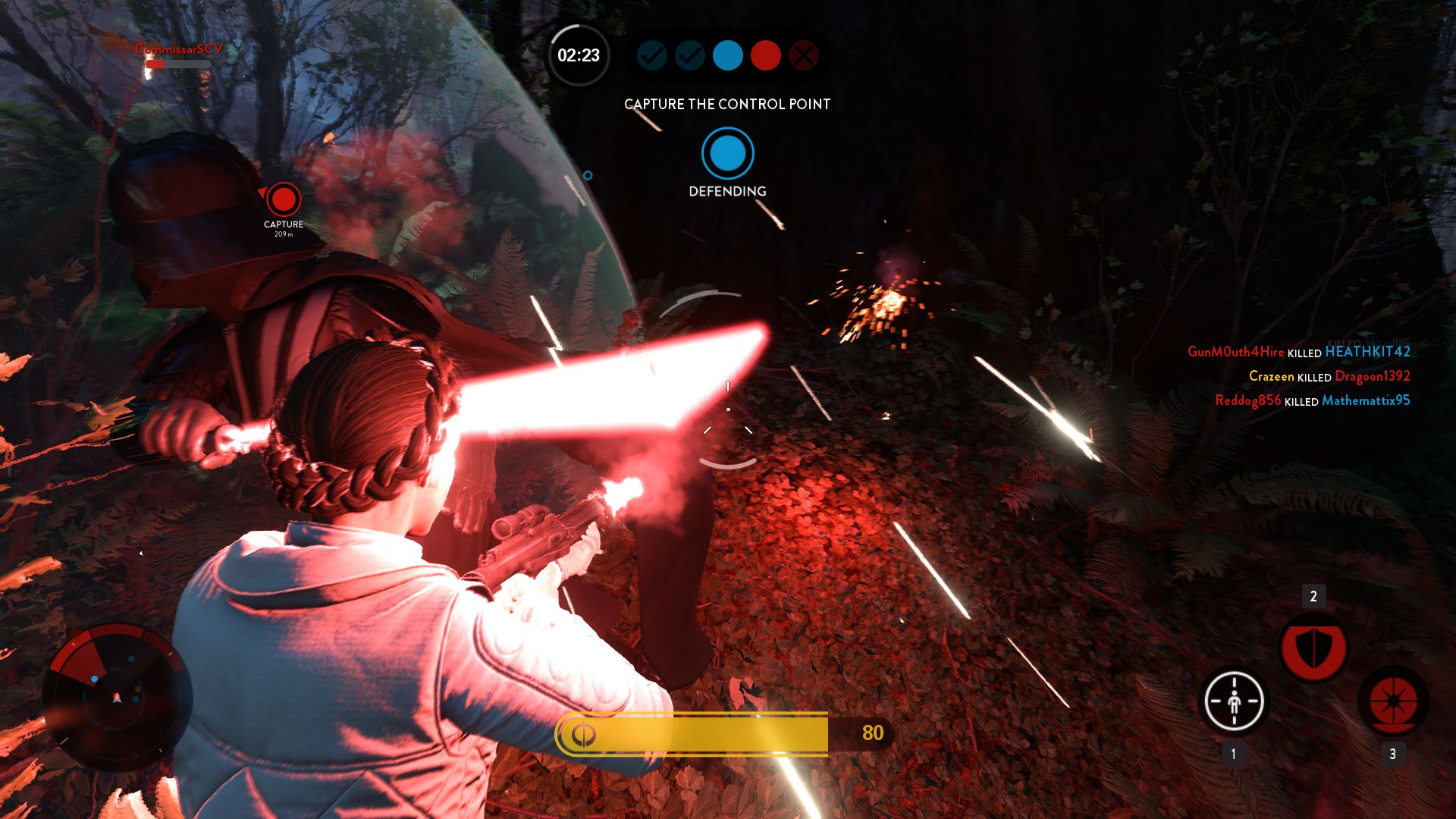
Less violent than most family reunions
Star Wars: Battlefront looks absolutely stunning. The Frostbite engine has been an asset in recent games and it looks ever better here. Although the destruction in Battlefront is minimal—even less than in Battlefield: Hardline—it more than makes up for it with lighting, textures, reflections and visual effects. DICE have faithfully recreated planets, characters, droids, vehicles and even structures from the movies. The attention to detail is exceptional, from the mud that collects on your boots to ice forming on your weapon. The engine is particularly good at rendering landscapes and this is demonstrated across the four main planets of Hoth, Endor, Tatooine and Sullust. Whether running through the ice caves on Hoth or jumping over magma flows on Sullust, the environments are stellar. Tatooine makes good use of sand, despite its coarseness and propensity to get everywhere, along with rocky outcrops. Endor is on another level though, with perhaps the best foliage since the lush grasses in the third Crysis game. Plants sway beneath your feet as soldiers battle on treetop walkways. Trees are felled by explosions—they even creak on decent—and sparks rain down from bark. The free DLC released at the start of December included another beautiful planet, Jakku, and it has vehicle carcasses strewn about sand dunes while battles rage overhead. The engine has no problem rendering these locations, maintaining high framerates on ultra settings. When it comes to the visual emulation of Star Wars, Battlefront is nearly perfect.
Frostbite is also known for its superb audio effects and the association with Star Wars is a recipe for success. The exacting sounds are found in everything from the standard blaster zaps to the booming thuds of the AT-AT walkers progressing through a canyon. It might be as subtle as the twangy reverberation noise when the heavy blaster ceases firing, or the minimalist beeping from a thermal imploder about to eliminate nearby enemies. Friendly soldiers will make comments about the match—they complain when you shoot friendlies and ask if you are injured. The musical score is also quite good, with some original works that blend well with the official theme. The sound and visual package is one of the best this year.
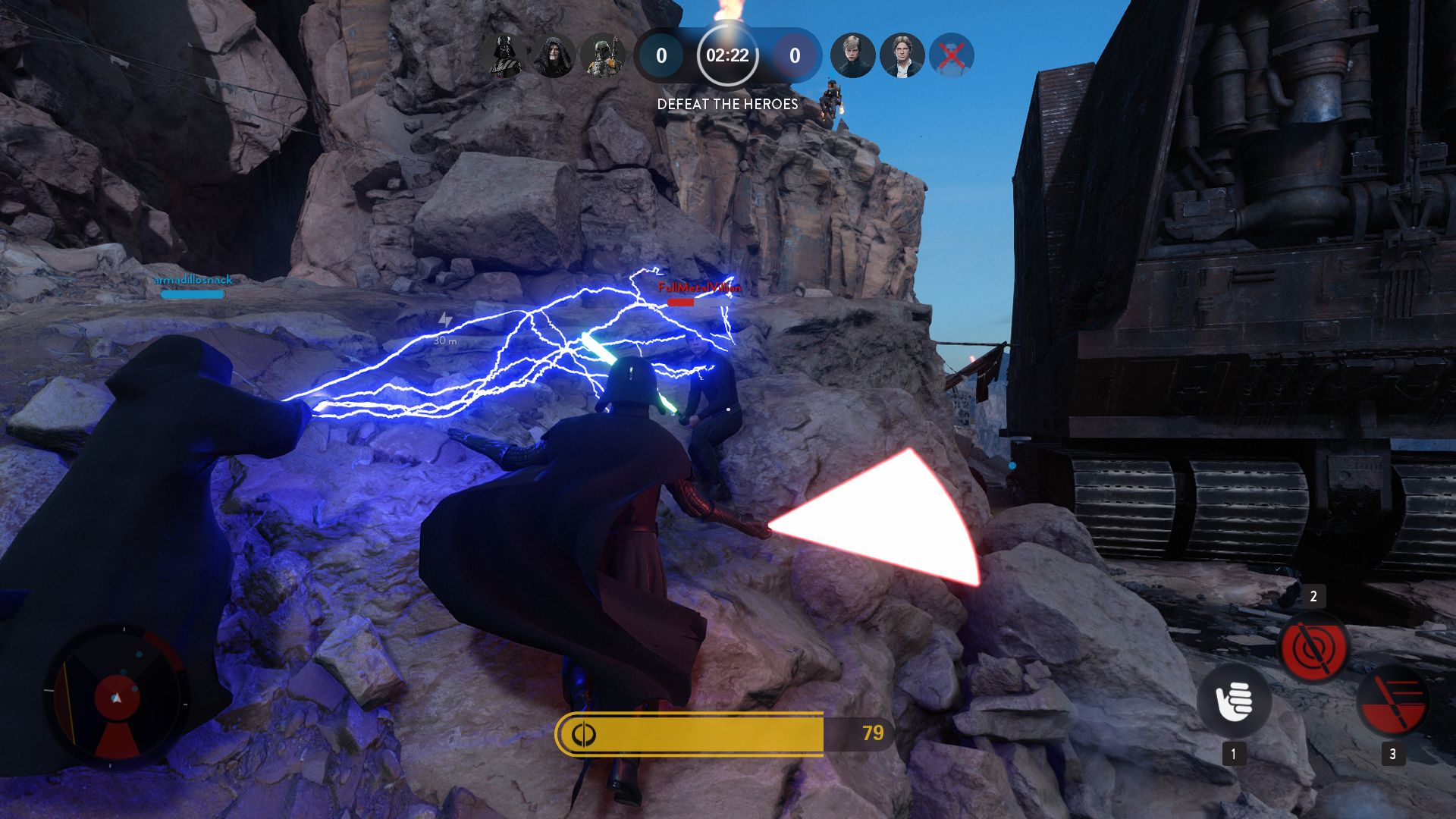
Just like Return of the Jedi, well, almost
But, how does it play? Not quite like Battlefield, but there are similarities. It aims for a more arcade experience, which makes sense given the very large potential target audience. Unlike Battlefield, there is a third person view that can be exploited cheekily by peaking around corners. There is no accuracy penalty for not aiming down the sights, which is quite refreshing and quickens the pace. Movement is also rapid with infinite sprinting. Clamouring over uneven ground is mostly trouble free, although you will still struggle up inclines. Energy projectiles from blasters travel slowly, which means leading distant targets. There are various blaster types, roughly equivalent to modern guns—pistols, heavy blasters (light machine guns), and even a shotgun type blaster.
The action is not just blaster fire, as many deaths will come from Star Cards. Three different Star Cards form a hand—you can only create two hands—and two cards are basically equipment slots with the third being a charged card that acts like a modifier or special ability. Cards can be purchased, and upgraded, using credits earned from playing, and these credits can also unlock different soldier faces and emotes. The two main cards are for equipment like grenades, sniper rifles, or a jump pack. They have a short cooldown and infinite uses. Using two grenades feels like cheating, since you can spam them together for easy kills. The charged Star Cards can briefly modify blasters to fire explosive projectiles or give them extra damage against shields and turrets. One charged card reveals enemies through walls for a short time. These charged cards have a limited use, so refills must be purchased or collected from maps. Although there is good variety, the balance is not perfect. With so many powerful explosive cards, the encounters are short, but it deemphasizes the elegant blaster combat. Not necessarily a bad thing, but it can result in cluttered combat when more than a handful of soldiers are nearby.
There is a fourth slot, which is filled by collecting Powerups found around maps. These can be stronger than Star Cards, providing bonuses like a rocket launcher, orbital strike, droid ally or a deadly proximity mine. Powerups are the only way to enter most vehicles. Heroes (and Villains) are usually accessed via Powerups; you can play as one of six characters from the universe, including Darth Vader and Han Solo. These characters absorb heavy damage and can return quickly after death. It takes a concerted effort from dozens of regular soldiers to eliminate them, costing many lives. Although having a hero on your side is neat, and playing one is empowering, being continually killed by an enemy hero unit is frustrating. You cannot avoid them like you can vehicles and they can decimate groups of soldiers in tight spaces. Most Powerups are placed near spawn locations, so everybody will get a chance to use them.
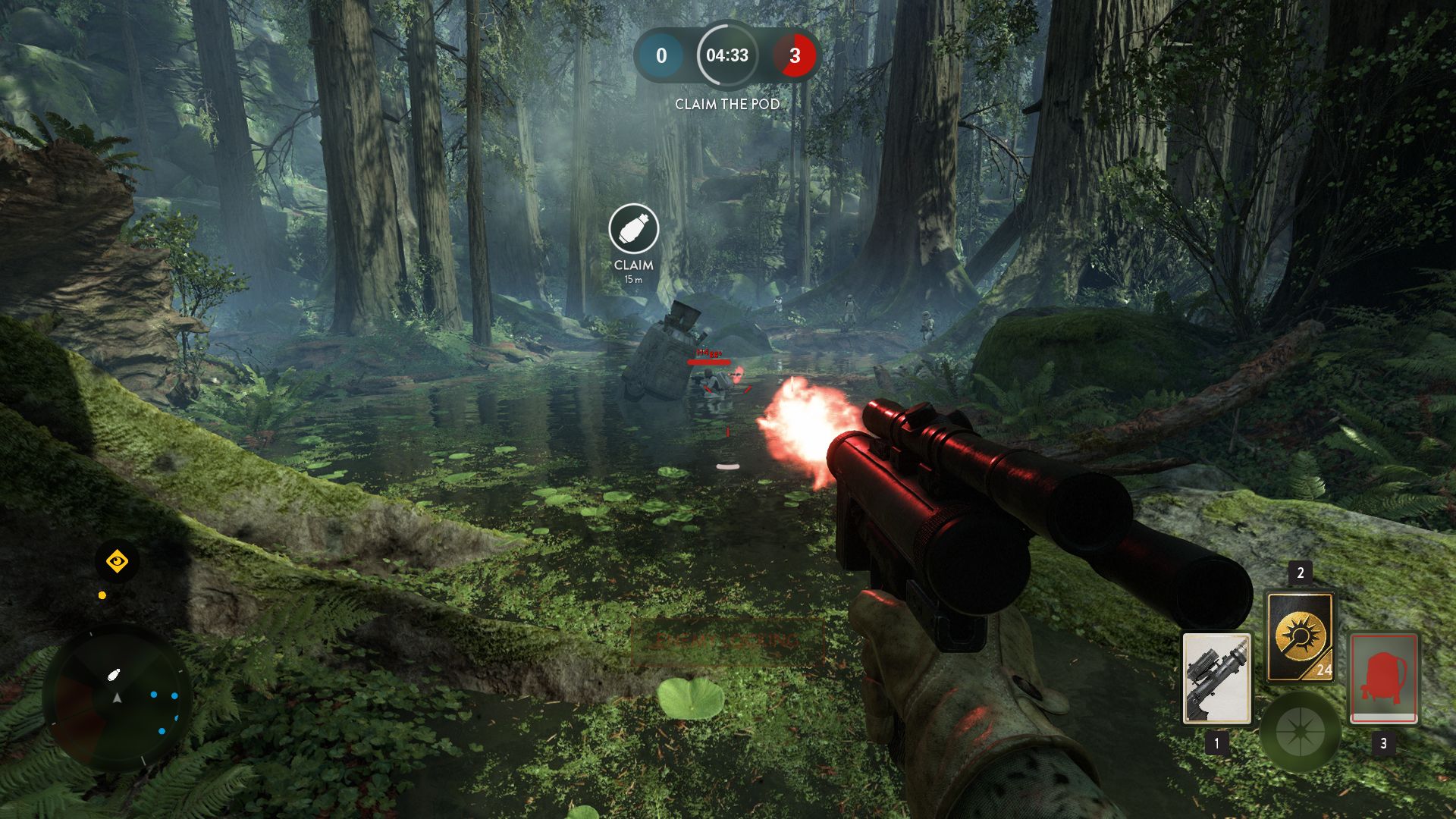
Powerups drop when the pod is captured in Drop Zone, here on beautiful Endor
Battlefront is packed with quite a few modes, from small infantry modes to large ones with vehicles. Fighter Squadron is the only mode sans ground combat, taking place in the sky with starfighters—think Flight Supremacy from Battlefield. If you ever wanted to pilot a TIE fighter and destroy Rebel scum, now is your best chance. It is quite accessible because of target-locking lasers, push-button evasive manoeuvres and fast kills. Unfortunately the mode lacks longevity partially because it has dozens of AI-controlled enemies that are pure fodder. It is little more than flying to the middle of the chaos and shooting the first thing that comes into range, occasionally weaving into a nearby canon to repair. While initially exciting, the only squadron element comes from hearing allies perish in battle or attacking their pursuers. It is also problematic when it comes to balance; the Empire won just once from dozens of games and the powerful Millennium Falcon typically survived the entire match. Fighter Squadron epitomizes Battlefront—spectacle over substance.
The main large game modes with ground combat are Supremacy and Walker assault, and both share the same maps with 20v20 player counts. These two modes, especially Walker Assault, have more cinematic moments than any of the other modes combined. They have vehicles, aircraft, capture points, hero units, turrets—almost everything that Battlefront offers. There are only four large maps (five with Jakku), and they are quite narrow albeit fairly long. Walker Assault is linear, with the massive Walkers trundling through canyons or riverbeds. At each stage Rebels activate defensive uplinks to damage the Empire’s Walker—it must be destroyed before the final point. But in Supremacy, the action is more like a futile tug of war as both teams retake one of two capture points and push enemies back, much like how it worked in Frontlines: Fuel of War. With the prevalence of powerful Hero units, vehicles and some dubious chokepoint design, it can mean soldiers contest for minutes without making progress. This stagnation brings fatigue and Supremacy might have worked better with ground soldiers only. Turning Point is another large mode, added with the first free DLC pack, and it functions like a hybrid of Walker Assault and Supremacy. This time Rebels are attacking via attrition and progress in a linear fashion, capturing one control point at each stage. Sadly it is only playable on one map.
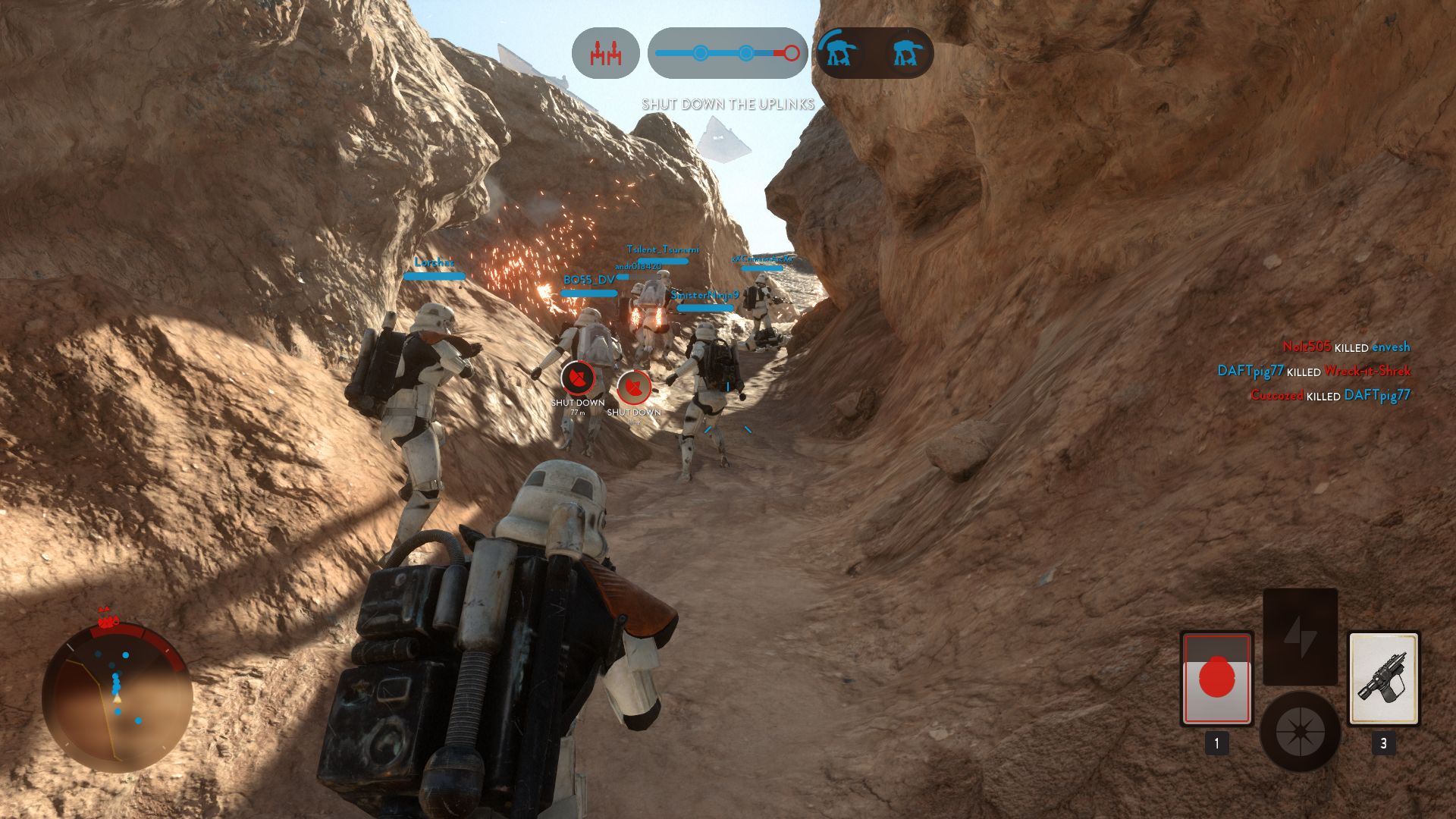
No Jump pack? Welcome to chokepoint city, population: too many
The general map structure in these large modes is poor. Narrow maps are not good at the best of times, but movement is restricted further by funnelling players down narrow corridors or through open canyons that lack cover. For the Rebels, Walker Assault is like shooting fish in a barrel unless an AT-ST or Villain pushes forward and camps a spawn point. Using a Jump Pack improves things, but the restrictive mission zones prevent too much flanking. Objectives are often found in cramped locations, which is annoying given the frequency of explosive devices. The similarly linear Jakku map has little in the way of structure—sand dunes and destroyed vehicles providing intermittent cover and plenty of cheap hiding spots.
The large modes thrive on imbalance, either temporary or permanent. The most obvious is that Empire Stormtroopers have white armor while the Rebels don their camouflaged gear; Rebels are nearly impossible see in the forests of Endor until they fire blasters. So how does the game balance the sides? Not well, unfortunately, giving the Empire one or two AT-ST vehicles while the Rebels have heavy turrets and better defensive positions. The binary changes in power from powerful units will often make progress irrelevant since heroes can capture objectives. Rebels might need Star Cards to deal with vehicles and the Empire might need the wall hack—sorry, Scan Pulse—just to find soldiers hiding in the shrubbery. Players who reach level 50 can unlock a black Shadowtrooper which is even harder to see than the camouflaged Rebels in some situations.
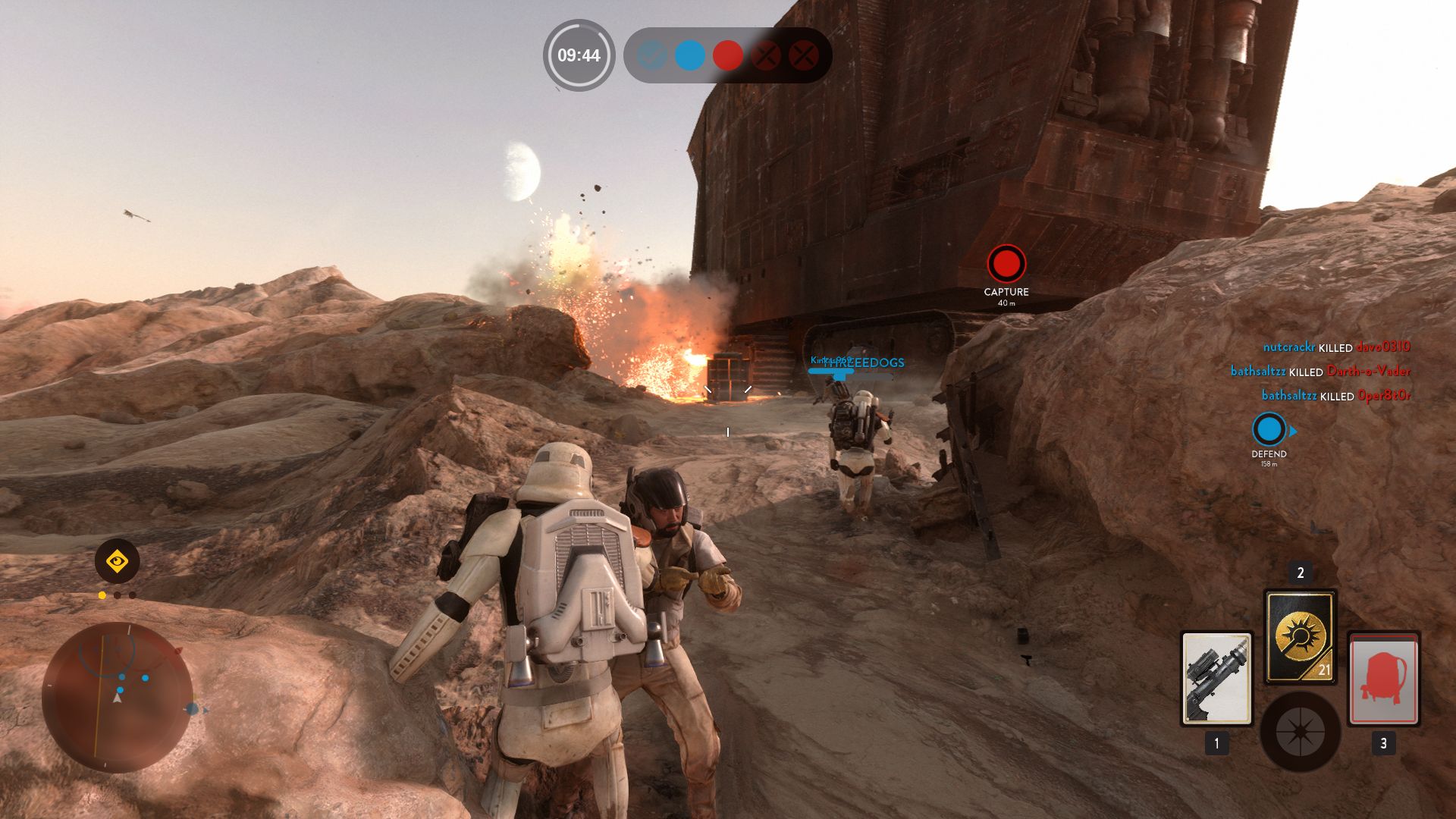
This Rebel spawned under my nose, two more followed within seconds
The worst problem in these large modes is the terrible spawn points. Players will often spawn beside opponents engaged in combat. Enemies will spawn directly under your crosshair multiple times within seconds. There are even situations where the spawns change while players are capturing objectives, effectively punishing attackers. And it gets worse. One Rebel soldier had the misfortune of spawning under an exploding AT-ST. Air units are able to camp enemy air spawns because you do not immediately gain control of starfighters. Even when the spawns are not so obviously horrible, they are still maddening due to map structure. When the Rebels get pushed to the final point on Hoth, they will spawn in the middle of nowhere with zero cover. It was not uncommon to spawn alongside 10 friendlies in a narrow corridor; one accurate grenade killing every solder attempting to find the exit. The December patch alleviated spawning issues in Walker Assault by spawning players far away from the objectives. Supremacy remained awful because the frontline changes rapidly, placing soldiers amidst enemy forces. The luck-of-the-spawn is often more important than player skill. It can be utterly decimating as you suffer death after death with no reprieve. You cannot choose where to spawn unless you have a partner that serves as a mobile spawn point and even then you will spawn in battle. The abysmal spawning ruins both large modes and requires a complete overhaul.
The infantry-only modes work much better, due to balancing, maps and more reasonable spawns. Player counts for these modes range from 6v6 to 10v10 and they are generally pleasant because of their simplistic objective designs. Compared to the large modes, there are more routes and fewer soldiers. There is still plenty of action, but you have more control over when and where it takes place. There are quite a few different infantry modes, including Blast (team deathmatch) and Cargo (capture the flag). Drop Zone has two teams chasing randomly-placed drop pods, which gets quite competitive and exciting as they are recaptured multiple times. Droid Run is like domination, capturing moving droids instead of flags. Aside from the Hero Hunt and Heroes vs Villains modes, these smaller modes don’t have the powerful hero characters or vehicles. This allows a broad spectrum of Star Cards to be effective without as much background noise. Spawns are less of a problem too, although respawning in front of a Cargo carrier—that just killed you—is horribly unfair. The spawning tends to keep the teams in clusters, but primarily there are fewer shifts in power to put the spawn system under pressure.
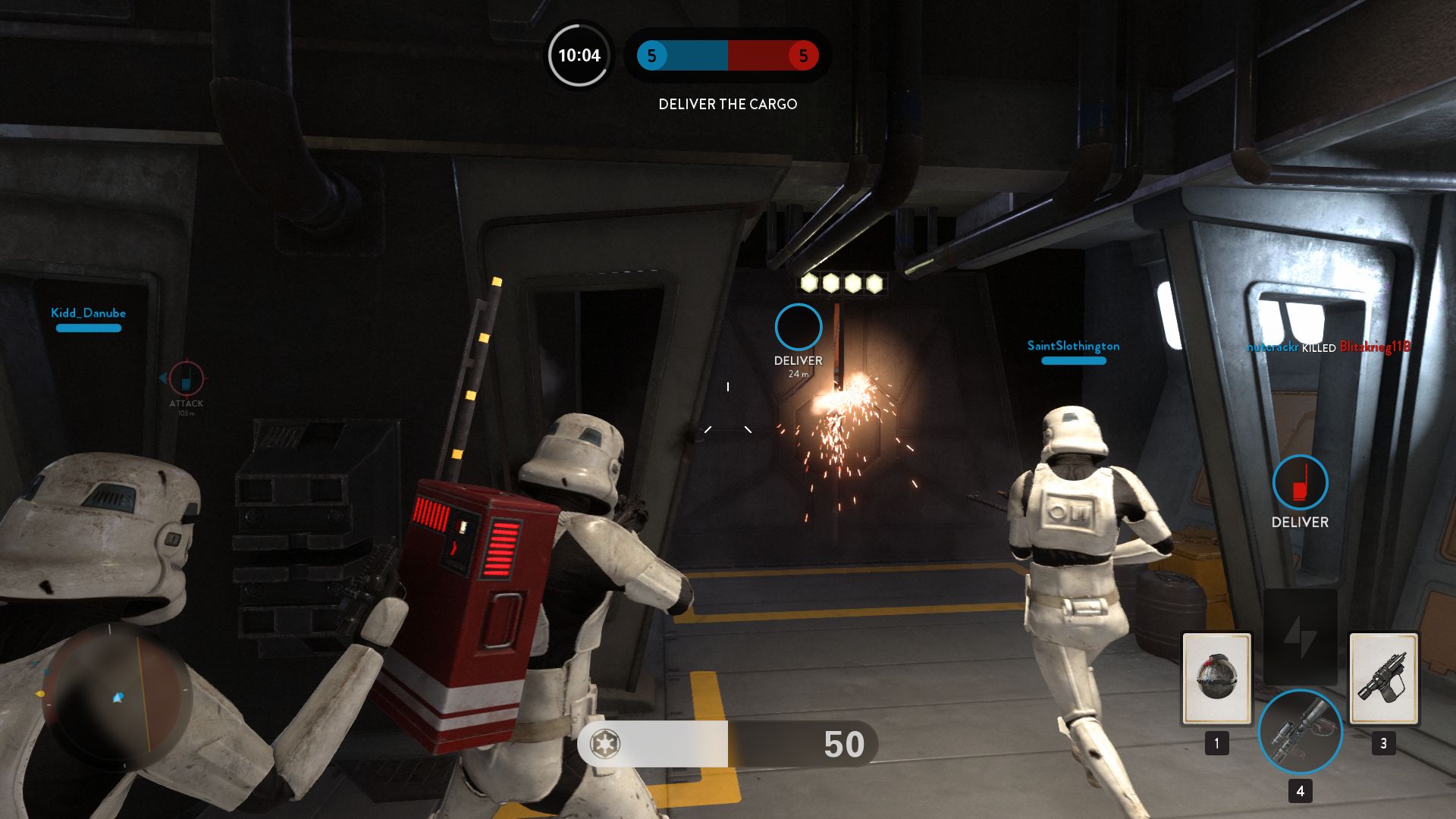
Cargo is actually quite enjoyable and has more natural teamwork than most modes
These small infantry modes take place on the nine confined maps that are not just subsets of the big maps. There are several good map/mode combinations. Drop Zone on Sullust is a good size and allows flanking even without a Jump Pack. The Imperial Station on Endor makes for interesting Cargo matches thanks to the side interior corridors around a central area that has suitable cover. The Endor crash site is perhaps the best of Battlefront visually and structurally, with careful lighting and multiple interesting action spots. Most small maps function well, but there are some hiccups. Bad examples include Drop Zone in the Ice Caves on Hoth, where your entire team can spawn on the other side of the map and will struggle to even reach the pod in time—never mind the horror that arises from explosives near cave entrances. The Rebel Depot can be just as bad, with major chokepoints that can see one team win quite easily if a drop pod lands behind them. These infantry modes also need to shuffle teams between matches, especially since you cannot manually switch sides, but when teams are even they are great fun.
Battlefront is disappointing when it comes to connectivity, especially compared to DICE’s previous games. The game uses automatic matchmaking, which means everything is hidden from the player. You cannot see what modes are popular, there is no server browser, and you cannot set maximum ping. In fact, you cannot see pings at all, only accessible via a console command. Server connections were inconsistent, although very few matches were completely unplayable. These problems could be localized, but playing on a server with a 200ms ping resulted in quick deaths, grenades disappearing, weird player collisions or delays after kills. Quickly matching into full games is nice, but not preferential to low-ping server that will always be more responsive. The slight differences in responsiveness can be frustrating. Occasionally the game failed to find a game in any mode, and waiting for 30 players just to start is ridiculous. With a plethora of modes, and future DLC that may split the community, these issues are a concern. What a shame DICE has gone backwards and that the most recent Call of Duty game has better connectivity on the PC.
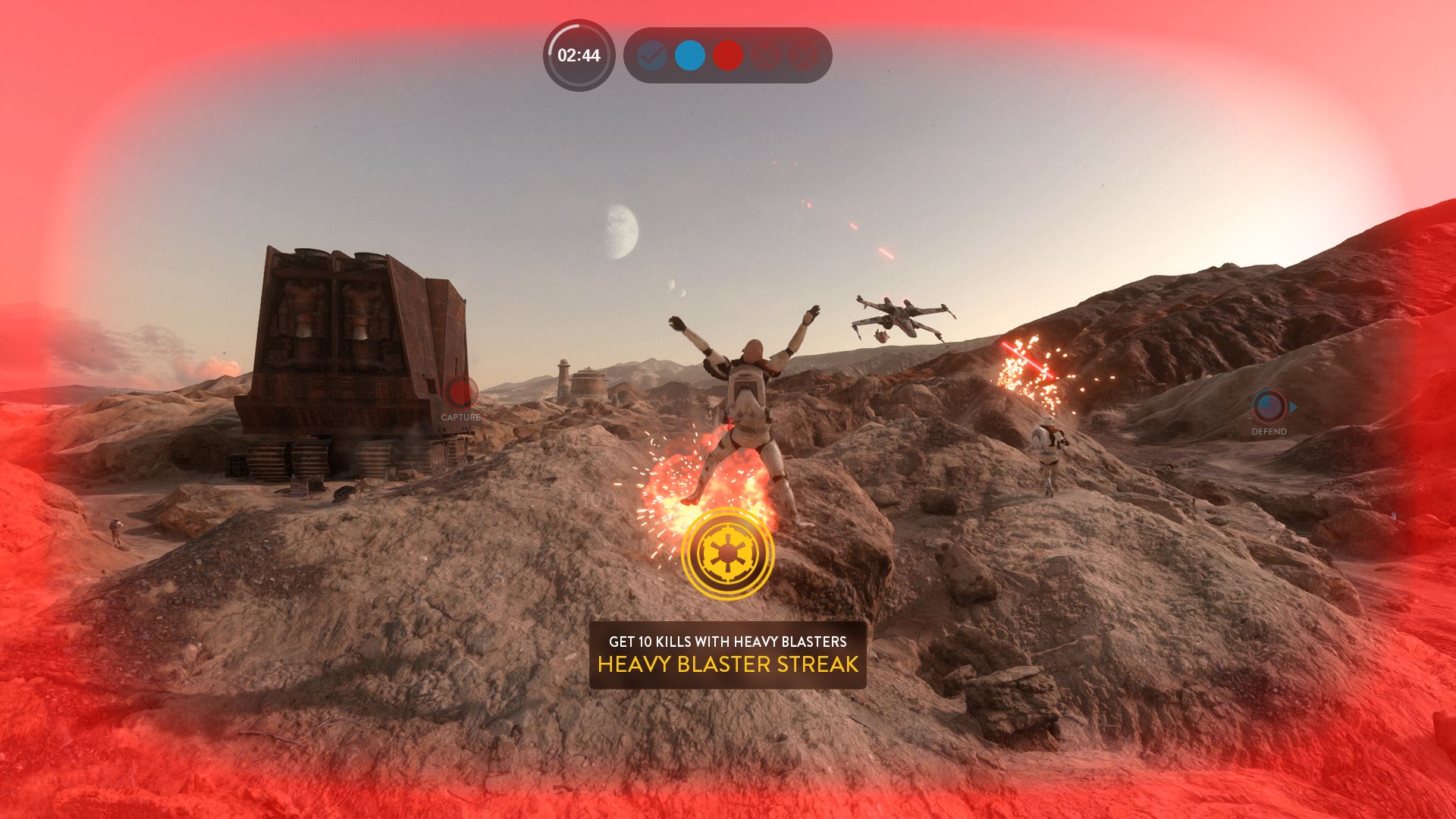
Put your hands up if you are frustrated with Star Wars: Battlefront
Battlefront is a multiplayer shooter, but DICE have added a few solo and co-operative missions. Training missions are a good way to become familiar with the basics, like flying aircraft, although they won’t take long to complete. Battle missions are effectively bot matches where you collect tokens from defeated enemies. You can play these as a hero, which is a great way to learn their abilities without the pressure of an online match. Survival offers the most value, as you defeat 15 waves of enemies which might take 30 minutes. On Hard or above, survival is difficult as you face cloaked Shadowtroopers, multiple AT-ST vehicles, shielded enemies and even TIE fighters. Survival can be entertaining but you can only use two predetermined Star Card hands, presumably for balance reasons—how bizarre that solo mode is more concerned about balance than the multiplayer. Some maps from these missions would have been great additions to the limited multiplayer offerings too. These solo and co-op modes are fairly insubstantial although they might be worth playing once.
It is easy to love Star Wars: Battlefront because of its authenticity to the universe, but it is easier to fault it for its mistakes. The excellent visuals, guided by accurate depictions of just about everything from the original movie series, can only take the game so far. Unfortunately the multiplayer suffers balance problems and can be frustrating. The large modes are compromised by dubious map structure and truly awful spawn points. It becomes a test of stamina just to keep playing them. The smaller modes are sustainable and enjoyable, although they are not perfect and seem to be less popular. With a limited number of maps, and a bland collection of solo missions, there are some questions about value. Star Wars: Battlefront is like a young Jedi that failed to complete his training and turned to the Dark Side because an inhospitable planet broke his resolve. The Star Wars movies taught us there is a way back from the Dark Side—it just might take a few sequels.
